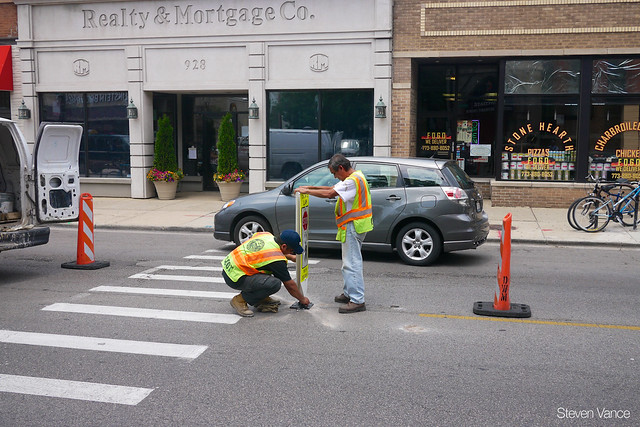An article in Monday’s Tribune confirmed what we already knew: Chicago’s “Stop for Pedestrians” signs have been taking a beating from careless drivers. In 2012, the city began installing the placards by crosswalks at unsignalized intersections. The Trib reported that 78 percent of the 344 signs installed have been replaced after motorists crashed into them.
The Chicago Department of Transportation estimates that a total of $265,000 has been spent so far to install and replace signs. Material and labor for replacing a sign at one location costs $550. Usually, two are replaced at the same time, which costs $920. Even so, the amount the city has spent on sign replacement comes out to roughly five cents per Chicagoan.
CDOT Commissioner Rebekah Scheinfeld told the Trib that this minimal expense is worthwhile. "The signs have gone a long way in increasing driver awareness of the four-year-old state law" requiring drivers to stop for pedestrians, she said.
Deputy Commissioner Luann Hamilton said the same thing at a Mayor's Pedestrian Advisory Council Meeting earlier this month: "I think it’s worth $920 to put them out there, even at the frequency of every 6-12 months."
The price tag for installing and replacing the signs pales in comparison to the price of losing life and limb to crashes. The Centers for Disease Control and Prevention estimated that pedestrian fatalities cost the Illinois economy $168 million in 2005. CDOT estimates the social and economic cost of each crash as $53,000 per injury, or $3.8 million per death [PDF].
48th Ward Alderman Harry Osterman endorsed the value of the placards, telling the Trib that his ward has "replaced our fair share of these signs, but people are slowing down and stopping" as a result. An Active Transportation Alliance study confirmed that signs are working. The report found that three times as many drivers stopped for pedestrians at Cook County crosswalks with the signs than at crosswalks without them.
The signs themselves aren't the problem here. Rather, it's the reckless drivers who are running them over. If CDOT ever decides that replacing the signs is too expensive, here's a more cost-effective alternative: crosswalk enforcement cameras. Washington, D.C. has installed the cams at 16 marked crosswalks to ticket drivers who fail to stop for pedestrians. A poll found that nearly 60 percent of people who don't drive think the crosswalk cameras are a good idea.
Currently, the Chicago signs are bankrolled by menu money in wards where the alderman supports the initiative, which means that some parts of town aren't getting their fair share. Scheinfeld said the fact that motorists are taking out so many of them shows that more traffic education and enforcement is needed on a citywide basis. "[The signs] are highlighting that there is a need to improve motorist awareness and rules-of-the-road compliance."





